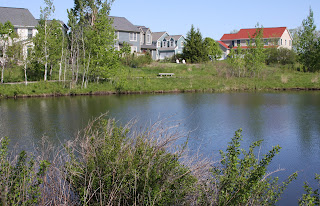Category:
Student efforts to protect water from pharmaceutical contamination head to Brazil
January 18th, 2013 by Irene MilesIISG’s Unwanted Meds program assists DEA’s nationwide drug take-back event
October 2nd, 2012 by Irene Miles Thousands of residents in Illinois and Indiana came out last Saturday with the goal of ridding their homes of unwanted pharmaceuticals as part of the Drug Enforcement Administration’s (DEA) 5th annual National Prescription Drug Take-Back Day. From 10 a.m. to 2 p.m. police officers and volunteers in more than 200 locations in Illinois and 70 in Indiana collected bottles, boxes, and sometimes even garbage bags full of prescription and over-the-counter human and veterinary medications. Everything collected will be properly incinerated by the DEA.
Thousands of residents in Illinois and Indiana came out last Saturday with the goal of ridding their homes of unwanted pharmaceuticals as part of the Drug Enforcement Administration’s (DEA) 5th annual National Prescription Drug Take-Back Day. From 10 a.m. to 2 p.m. police officers and volunteers in more than 200 locations in Illinois and 70 in Indiana collected bottles, boxes, and sometimes even garbage bags full of prescription and over-the-counter human and veterinary medications. Everything collected will be properly incinerated by the DEA.Single-day collection events like this are an important way to limit negative impacts to wildlife and local waterways from prescriptions and medications that are improperly disposed of. A wide-range of pharmaceutical chemicals has been found in rivers, groundwater, and drinking water throughout the country due to medications being flushed down the toilet or thrown in the trash. The impact of these chemicals on long-term human health is still unknown, but a connection between pharmaceutical-contaminated waters and impaired development, behavior, and reproduction has been found in many species of fish and other aquatic wildlife.
IISG has been educating people on pharmaceutical stewardship issues and helping communities establish safe and legal permanent medicine collection programs for more than six years. For additional information on how to dispose of medicine between take-back events or in areas where collections are not available, visit www.unwantedmeds.org.
Kimiko Pettis wins Sea Grant PPCP Stewardship Award for classroom PPCP projects
August 7th, 2012 by Irene MilesLocal water travels a long, long way
June 25th, 2012 by Irene MilesWatersheds are areas where water comes together and drains to a common place. In addition to the streams and rivers and creeks that we can see, though, watersheds encompass a huge range of pathways for water, and your nearby water supply might be part of a very large system that spans multiple states.
“Of course, obtaining sustainable development in town isn’t enough, in and of itself, to guarantee high quality, fishable and swimmable rivers and streams. Industry plays a part; utilities and waste water treatment plants play a part; sensitive farming, ranching, and/or timbering play a part, all in different proportions depending upon the particular watershed in question.”
Sea Grant message reaches many thousands in Times Square — The Movie
April 23rd, 2012 by Irene Miles
In partnership with the American Veterinary Medical Association, the Sea Grant program created a 15-second public service announcement that aired on the CBS JumboTron “Super Screen” on 42nd St. in New York City from late December through March.
Recent News
- IISG’s Eliana Brown wins 2025 Illinois Extension Excellence Award
- We’re hiring eight interns for summer 2026
- In 2026, IISG intends to fund 10 research projects focused on coastal concerns
- IISG looks back on 30 years of AIS outreach
- New step-by-step guide and veterinary brochures expand UnwantedMeds.org resources
IISG Instagram
This fall, our staff made a splash at the @ilsciteaching Conference, @sheddaquarium Educators’ Conference, and the Place-Based Education Conference.
Would you like to know where you can catch up with our education team in 2026? Sign up for our Education Newsletter at the link in bio or
https://iiseagrant.org/education/subscribe-to-education-newsletter/
Photos by Michigan Sea Grant and Illinois-Indiana Sea Grant

🌊 Save the Date! 🌊
Shipboard Science Immersion 2026
Join the Center for Great Lakes Literacy aboard the R/V Lake Guardian on Lake Superior, July 7–14, 2026!
✅ Open to formal & nonformal educators (grades 5–12) across the Great Lakes region.
📅 Applications open January 2026
Learn more: https://cgll.org/signature-program/r-v-lake-guardian-shipboard-science-immersion/ or the link in bio.
#TeachingTuesday

Join the Invasive Crayfish Collaborative for an exciting webinar featuring Dr. Chris Taylor from the Illinois Natural History Survey who will provide an overview of midwestern crayfish habitat requirements, feeding, reproductive biology, and life-history.
Crayfishes in the Midwest occupy almost every type of aquatic and semi-aquatic habitat in the region. They function as critically important components of those ecosystems and in many cases represent a majority of invertebrate biomass. As “keystone” species, understanding their biology and roles in ecosystems is critically important.
Register for the webinar at InvasiveCrayfish.org/events1 Or the link in bio.

This season, let’s teach eco-friendly habits while spreading cheer! NOAA’s Greener Holiday Gift Guide is full of ideas to reduce waste and protect our precious water resources.
Check out the full guide at the link in bio.
#teachingtuesday
NOAA Marine Debris
NOAA Education

Categories
- Aquaculture
- Aquatic Invasive Species
- Buoys
- Climate Ready Communities
- Coastal Resilience
- Director's Blog
- Education
- Featured
- Fellowships
- Fisheries
- Funded Research
- Funding
- Great Lakes Cleanup
- Great Lakes Data
- Healthy Waters
- Internships
- Jobs
- K-12 Education
- News
- Photos
- Program
- Recreation & Tourism
- Resources
- Sea Grant Scholars
- Stormwater & Green Infrastructure
- Sustainable Community Planning
- The Helm
- Uncategorized
- Video
- Water Resource Economics



